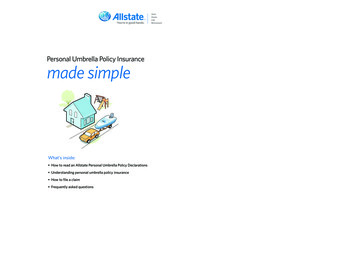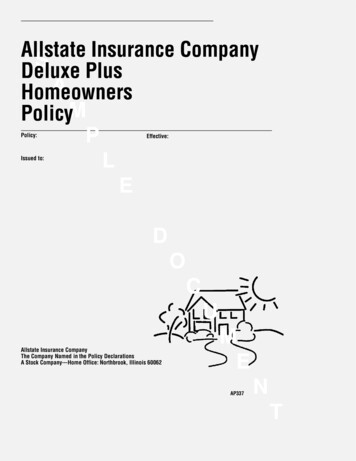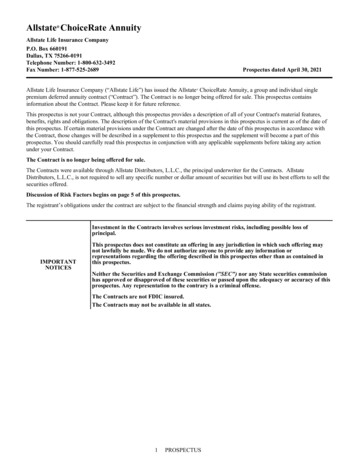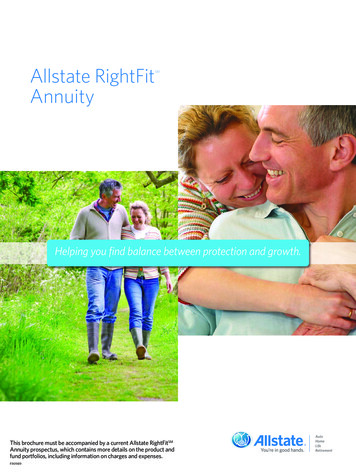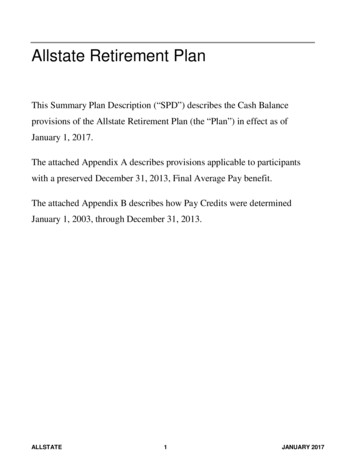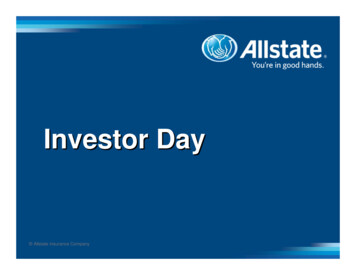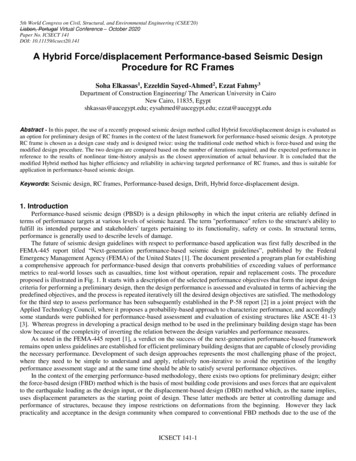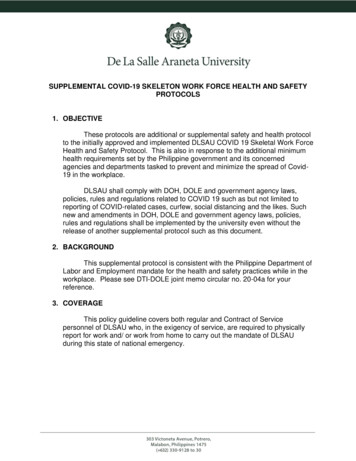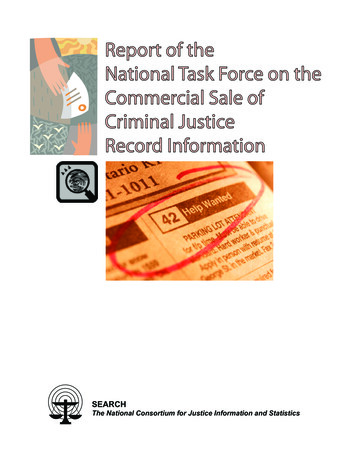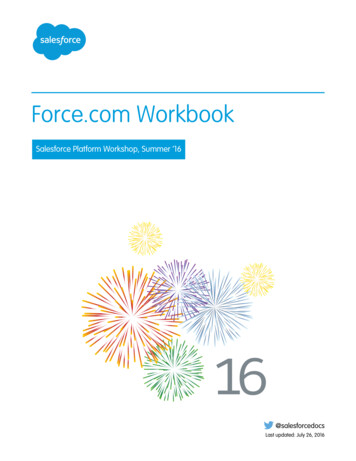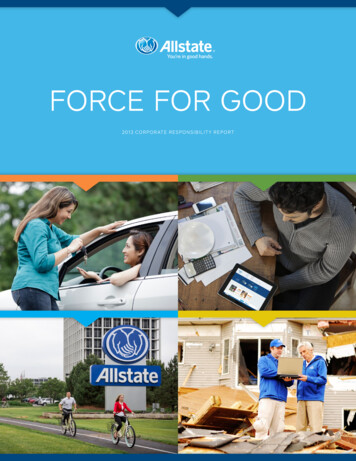
Transcription
FORCE FOR GOOD2013 CORP OR ATE RESP ONSIBILIT Y REP ORT
ABOUT THIS REPORTGRI DISCLOSURES1.2 / 2.9 / 3.1 / 3.2 / 3.3 / 3.4 / 3.5 / 3.6 / 3.7 / 3.8 / 3.9 / 3.10 / 3.11 / 3.13 / 4.1 / FS1 / FS4 / FS5 / FS9Allstate is committed to reporting each year about oursustainability performance. In this, our 12th CorporateResponsibility report, we share our achievements as wellas areas where we see opportunities for improvement.Throughout this report, we also provide examples of how weapply our knowledge to improve our company, enhance oursustainability efforts and address stakeholder concerns.REPORT CONTENTReport content is determined both by the Global ReportingInitiative (GRI) framework and through our understandingof stakeholder priorities and concerns. Stakeholders includecustomers, employees, agency owners, investors, opinionleaders, policymakers and consumers. We also regularlyreceive feedback from and engage with a wide variety ofcommunity groups, nongovernmental organizations (NGOs)and activist organizations, and staff members fromorganizations that regulate our business and operations.We use this feedback to help guide all aspects of ourcorporate responsibility strategy.ASSESSING CHANGING ISSUES:THE ALLSTATE MATERIALITY THINKTANK SUMMITIn early 2014, academics, NGO executives, corporateresponsibility professionals, journalists and consultantsmet online in a virtual “Think Tank” to discuss emergingsustainability issues for Allstate. The idea was to do aquick pulse-check, rather than a full re-evaluation, on theMateriality Analysis/Matrix Allstate created in 2011. TheMatrix is an important element of Allstate’s corporateresponsibility effort, since it identifies the sustainabilityissues that impact Allstate’s business from our stakeholders’point of view.2 OVERVIEW / About this reportPlease send correspondence, comments and questionsregarding this report to: SocialResponsibilityFeedback@allstate.comAllstate collaborated with Convetit on a week-long virtual“Think Tank” using a stakeholder engagement platform.The online forum was convenient for participants, requiringno travel and allowing people to drop in when it wasconvenient for them. It was open to people from manydifferent organizations, gathering input on key materialityissues including: Environment: Environmental Management Operations Communities: Natural Catastrophe Preparedness Employees: Diversity & Inclusion; Employee &Agent Satisfaction Supply Chain: Sustainable Procurement Governance: Transparency; Risk Management &Business Continuity Products & Services: Access to InsuranceClimate change was by far the most hotly discussed subject,with stakeholders asking that Allstate take a stronger standon an issue that impacts its bottom line via increased claimsfor weather-related damages.Allstate already pursues a wide range of climate changeinitiatives, from carbon mitigation strategies and investmentportfolio decisions to risk management and disasterpreparedness efforts. This year, Allstate will take thatcommitment one step further with a formal climate changepolicy statement [link to climate change policy section],which is included in this year’s report.Beyond climate, stakeholders spotlighted the supply chainas a focus of material issues, and an opportunity to leverageour positive influence. Stakeholders asked that Allstate buildon its success in supply chain sustainability, incorporatingadditional impact measures like human rights. Allstate’sprocurement team is planning to embed sustainability withinall of their internal and external processes — and will bebenchmarking against other financial services companies inthe near future.ALLSTATE 2013 CORPORATE RESPONSIBILITY REPORT
Participants also pointed to employee engagement asAllstate’s strong suit and a possible springboard for futurecorporate responsibility initiatives. Andy Savitz, a principalat Sustainable Business Strategies, said, “The culture ofthe company appears to be one of caring and it wouldn’tsurprise me if many employees and agents care deeplyabout the environment and society. My guess is that byaligning sustainability and employee values Allstate couldmove the needle on employee engagement resulting inpotential significant business benefits.”OUR REPORTING FRAMEWORKThis is our fifth year using the GRI reporting framework,and first using the recently released “G4” guidelines. GRI isa set of global guidelines that standardizes sustainabilityreport content and facilitates comparisons among differentorganizations. The guidelines are continually refined andimproved to give companies a more effective framework fororganizing content.More information about our business and financialperformance is available in our Annual Report.REPORT PERIOD, SCOPE AND BOUNDARIESThis report was published in August, 2014 and covers oursustainability performance for the 2013 fiscal year, January 1,2013 to December 31, 2013.Reporting boundaries in other areas differ by content. Climate Change: Reporting covers Allstate and affiliateowned and leased facilities and operations in the UnitedStates, Canada, India and the United Kingdom. Energy: Reporting covers Allstate and subsidiary-ownedfacilities and operations in the United States, Canada,India and the United Kingdom. People: Reporting covers the employees of Allstate.Employees of exclusive agencies, independent agenciesand partners are not covered except when specificallynoted in the report. Products and Investments: Reporting covers all of ourproducts, financial services and investments duringcalendar year 2013.Information for this report was collected by individualdepartments within Allstate that gather, store andmanage data in their business systems. Cameron Cole,an environmental consultant, has verified the data in ourGreenhouse Gas inventory. All other data and statementsmade have been confirmed by internal Allstate teams,including representatives from Human Resources;Investments; Risk Management; Tax, Administrationand Real Estate; Sourcing and Procurement Solutions;Finance, Law & Regulation; Accounting; and our CorporateResponsibility team. No significant changes were made inmeasurement from previous reporting years.Data in this report does not cover the facilities, operationsand employees of our exclusive insurance agencies or theindependent insurance agencies who sell Allstate products,unless otherwise noted.3 OVERVIEW / About this reportALLSTATE 2013 CORPORATE RESPONSIBILITY REPORT
KEY PERFORMANCEINDICATORS AND GOALSGRI DISCLOSURES 3.10 / EC6 / EN18 / EN26 / EN5 / EN6 / EN7OUR KEY PERFORMANCE INDICATORS reflect our sustainability and social impactpriorities. This update shows where we achieved strong results in 2013 and where weare striving to improve.GOALSPROGRESSBUSINESS PRACTICESEMPLOYEE DIVERSITYEarn a spot on The DiversityInc Top 50 Companies for Diversity liston an annual basis. DiversityInc’s Top 50 measures four key areas:CEO Commitment, Human Capital, Corporate and OrganizationalCommunications, and Supplier Diversity.2013 – AchievedCompanies must score above average in all four areas to earn a spot onthe list and demonstrate strong consistency across the board in theirdiversity-management initiatives. Companies are measured within theirindustry classifications.2010 – Did not achieve2012 – Achieved2011 – Achieved2009 – Did not achieve2008 – Did not achieve (Named to DiversityInc’s 25 NoteworthyCompanies)2007 – Achieved2006 – AchievedSUPPLIER DIVERSITYAchieve 9% of Allstate’s total procurement spend with businesses ownedby minorities, women, veterans and members of the lesbian, gay, bisexualand transgender community by 2015.On Track to Achieve 2015 Goal2013 – 8.3%2012 – 6.6%2011 – 5.9%2010 – 5.4%2009 – 5.7%2008 – 4.1%2007 – 5.0%2006 – 4.2%4 OVERVIEW / Key performance indicators and goalsALLSTATE 2013 CORPORATE RESPONSIBILITY REPORT
GOALSPROGRESSENVIRONMENTENERGY REDUCTIONReduce energy use 20% by 2020 for Allstate-owned facilities(compared to our 2007 baseline).We are working to improve the energy efficiency of Allstate’s operations,reduce electricity demand and explore renewable energy options.On Track to Achieve 2020 Goal2013 – 19.39% reduction from 2007 baseline (10.87% reductionfrom 2012)2012 – 8.91% reduction from 2007 baseline (5.2% reduction from 2011)2011 – 3.91% reduction from 2007 baseline (4.12% reductionfrom 2010)2010 – 0.22% increase from 2007 baseline (0.71% reduction from 2009)2009 – 0.94% increase from 2007 baseline (0.22% increase from 2008)2008 – 0.72% increase from 2007 baseline2007 – Baseline setCARBON FOOTPRINTMaintain or reduce Allstate’s carbon footprint on an annual basis(compared to our 2007 baseline).Achieved2013 – Achieved (6.3% decrease over prior year; total 26.7% reductionsince 2007)We publish details about our environmental performance in our annualresponse to CDP (Carbon Disclosure Project). We are reducing our carbon2012 – Achieved (3.12% decrease over prior year; total 21.79%footprint primarily by improving the operational efficiency of companyreduction since 2007)owned buildings, using more fuel-efficient vehicles in our corporate fleetand regulating air travel by employees more carefully.2011 – Achieved (10.39% decrease over prior year; total 19.27%reduction since 2007)2010 – Achieved (3.16% increase over prior year; total 9.91% reductionsince 2007)2009 – Achieved (8.38% decrease over prior year; total 12.67%reduction since 2007)2008 – Achieved (4.68% decrease over prior year)2007 – Baseline setREAL ESTATEFocus on the sustainability of our real estate by ensuring that many majoroffice renovations and most new construction projects are Leadershipin Energy and Environmental Design (LEED) certified by the U.S. GreenBuilding Council.Achieved2013 – No new major construction or renovation projects2012 – Interior construction of Chubbuck-Pocatello call-in centerachieved LEED Gold certification; F Tower building at Home Officeachieved LEED certification for renovation of floors 7–92011 – New Idaho call center in Chubbuck-Pocatello achieved LEED Silvercertification2010 – Pursuing LEED certification of new Idaho call-in center inChubbuck-Pocatello, Idaho, slated to open in 20115 OVERVIEW / Key performance indicators and goalsALLSTATE 2013 CORPORATE RESPONSIBILITY REPORT
GOALSPROGRESSPAPER REDUCTION — EMPLOYEE FOCUSMaintain or exceed employee paper reduction levels established in 2010.AchievedAfter surpassing our 2009 goal to reduce overall employee office paperuse by 25% by 2010, we deemed 2010 to be our new baseline.2013 – Achieved (17% reduction from 2012 level; 31% reductionsince 2010)2012 – Achieved (12.8% reduction from 2011 level)2011 – Achieved (11.4% reduction from 2010 level)2010 – Established as our new baseline year after achieving 41%reduction in office paper in our corporate headquarters and morethan 50% in our field offices compared to our 2008 baseline2009 – Well on track to achieve 2010 target (21% reduction comparedto 2008 baseline)2008 – Baseline setPAPER REDUCTION — CUSTOMER FOCUSReduce paper delivery to customers by 20% by 2013 (compared to our2009 baseline).2013 – Reduced customer paper use by 33% since 2009 baseline,helping our customers save more than 56 million pieces of paperIn 2011, we surpassed our goal of reducing paper delivery to customersby 20% by 2013 through the use of convenient, cost-effective andenvironmentally friendly options such as EZPay, eBill and ePolicy.2012 – Reduced customer paper use by 27% since 2009 baseline, savingmore than 30 million pieces of paper2011 – Achieved. Reduced customer paper by 22.4%, savingapproximately 24 million pieces of paper2010 – Well on pace to achieve 2013 target: 11.8% reduction totalingapproximately 14 million pieces of paper saved2009 – Baseline setSOCIAL IMPACTTEEN SAFE DRIVINGContribute to reducing teen driving fatalities by 50% and create the safestgeneration of teen drivers by 2015.We are making “smart” driving socially acceptable to teens using thepower of peer-to-peer influence, guidance from key adults and increasedpublic understanding of the issue to change the way teens think and actin the car.2013 – On track to achieve 2015 target.The Allstate Foundation Teen Safe Driving program exceeded its socialimpact goals for 2013: more than 7.7 million teens were informed andmore than 1.2 million were involved in our teen safe driving programs inlocal communities. Teen deaths on U.S. roads have decreased by about47% since 2005.FINANCIAL EMPOWERMENT FOR DOMESTIC VIOLENCE SURVIVORSReach 500,000 survivors of domestic violence with Allstate Foundation–funded financial empowerment services by 2015.Empower domestic violence survivors to increase their financialindependence, which helps them end the cycle of violence to live andthrive free from abuse.6 OVERVIEW / Key performance indicators and goals2013 – On track to achieve 2015 target.In 2013, more than 171,000 survivors received financial empowermentservices through The Allstate Foundation program; more than 384,000have received these important services since the program began in 2005.From financial literacy to job training to asset-building projects,Foundation-funded programs are helping survivors move from safetyto security.ALLSTATE 2013 CORPORATE RESPONSIBILITY REPORT
LETTER FROM THE CEOGRI DISCLOSURES 1.1 / 1.2 / 4.8Allstate is a special place that is determined to “Be a ForceFor Good.” We live this by: Doing the right thing Putting people ahead of policies Defying expectationsIt’s what our customers want, what our communities needand what we expect of ourselves.We are driven by purpose and share a vision to safeguardthe hopes and dreams of more than 16 million families.Our iconic brand slogan is “You’re in Good Hands,” and wedeliver on that promise every day, protecting people fromlife’s uncertainties and preparing them for the future.In 2013, Allstaters brought the “Good Hands” to life forpeople in need in virtually every city in the country. Animpressive 65 percent of agency owners and employeeswere involved in corporate responsibility programs duringthe year, including a record 3,700 volunteers during ourannual Week of Service. We also contributed more than 29 million in financial resources to help more than 8,600nonprofit organizations.It’s this willingness to get involved, to lead by example andbe a force for social change that inspires us to set our sightshigher every year. That is especially true when it comes toour long-term commitment to reduce teen driving fatalitiesand help domestic violence survivors. We have taken a standto reduce violent urban crime through Get In Chicago. Inaddition, we initiated a relationship with Free the Children,an organization empowering youth to rise up and be activelocal and global citizens.Our focus on corporate responsibility includes Allstate’sbusiness practices as well. We seek growth and profitability ina responsible, sustainable way by having a diverse workplaceand supplier network and reducing our direct impact on theenvironment. I’m pleased to say we are making progress onthese goals, with the number of diverse suppliers 26 percenthigher than the prior year’s and carbon emissions nearly27 percent lower than six years ago.7 OVERVIEW / Letter from the CEOAllstate is a company that stands for good, and we caredeeply about our customers, employees, agency ownersand the communities we serve. Through our actionswe help people live a good life — every day. We all havea hand in tomorrow, and Allstate is committed to doingits part to help create a brighter future.Tom WilsonChairman, President and Chief Executive OfficerALLSTATE 2013 CORPORATE RESPONSIBILITY REPORT
LETTER FROM THESENIOR VP OF CORP.RESPONSIBILITYGRI DISCLOSURES 1.2 / 3.5 / 4.8Allstate is a company with a clear purpose: Bring more goodto peoples’ lives. We help our customers achieve their hopesand dreams by protecting them from life’s uncertaintiesand preparing them for the future. And we generously lendour financial support and human capital to create safer andstronger communities.Individually and collectively, Allstaters are driven to live ourbrand promise: You’re in Good Hands with Allstate. We do thisby always striving to do the right thing, putting people aheadof policies and defying expectations — delivering more thanwhat people would expect from an insurance company. Thosesimple but powerful brand attributes guide our decisions,anchor our processes, and help us create innovative ways tobring more good to our customers and the world around us.Allstate’s deep commitment to corporate responsibility isa natural extension of this intense focus on our customers,and it influences our interactions with other stakeholders,our business practices, the environment and society atlarge. We’re guided by goals established several years agothat have inspired us to significantly improve our corporateresponsibility performance. In fact, we will raise the bar onmany of our goals in 2014 to ensure we continue to challengeourselves and maintain our standing as one of America’sleading corporate citizens.the growth of local Allstate agencies, resulting in a20-point increase in their satisfaction with the agencycompany relationship.Following are some key highlights of progress in 2013 acrossour focus areas of stakeholder engagement, responsiblebusiness practices, environmental stewardship and socialimpact initiatives: Improved Allstate’s overall reputation from “average” to“strong” among all stakeholders: Elevated our focus oncustomer relationships and community involvement to helpspur this increase, as measured by the Reputation Institute.Stakeholders Advocated for our customers directly with Congress:Organized the first-ever Allstate Congressional Fly-in,which allowed our employees and agency owners toshare local perspectives with elected officials on issuesimportant to the customers we protect. Boosted satisfaction among employees: Received afavorable response from at least 75 percent of employeeson 10 of 11 key measures of satisfaction. Increased agency owner satisfaction with heightenedsupport: Refocused efforts to support and enable8 OVERVIEW / Letter from the Senior VP of Corp. ResponsibilityALLSTATE 2013 CORPORATE RESPONSIBILITY REPORT
Business PracticesSocial Impact Made great progress toward our supplier diversitygoal: Spent 409.6 million with diverse suppliers, or8.3 percent of Allstate’s total annual procurement.We expect to meet our goal of spending 9 percent ofAllstate’s total procurement on diverse businesses bythe end of 2014, a year ahead of schedule. Engaged a record number of Allstaters in communityprograms: Involved 65 percent of Allstate employees andagency owners in these efforts in 2013. Ranked among top companies for diversity: Includedon the DiversityInc Top 50 Companies for Diversity listfor the third year in a row, reflecting our core value ofinclusive diversity. Broadened reach of our Domestic Violence program:Financially empowered more than 171,000 domesticviolence survivors, helping women across the countryachieve the self-sufficiency they need to get free and stayfree from abuse. Maximized investments to deliver social impact:Maintained Allstate Investments’ nearly 1 billioncommitment to socially responsible strategies, suchas Low Income Housing Tax Credits and a program tohelp identify and develop minority- and women-ownedprivate equity firms. Led new public-private effort to reduce violence in ourhometown of Chicago: Helped launch — and continue tolead — a 50 million multiyear program to combat urbanviolence in the city with our sponsorship of Get In Chicago. Leveraged big data to combat insurance fraud: Createdpredictive modeling algorithms through Allstate’sQuantitative Research & Analytics team to help identifyand prevent claims fraud. Eliminating fraud is goodfor Allstate and for consumers who may benefit fromlower premiums.Environmental Stewardship Delivered big-time paper cuts (the kind that don’t hurt!):E
in the car. 2013 – On track to achieve 2015 target. The Allstate Foundation Teen Safe Driving program exceeded its social impact goals for 2013: more than 7.7 million teens were informed and more than 1.2 million were involved in our teen safe driving programs in local communities. Teen dea
